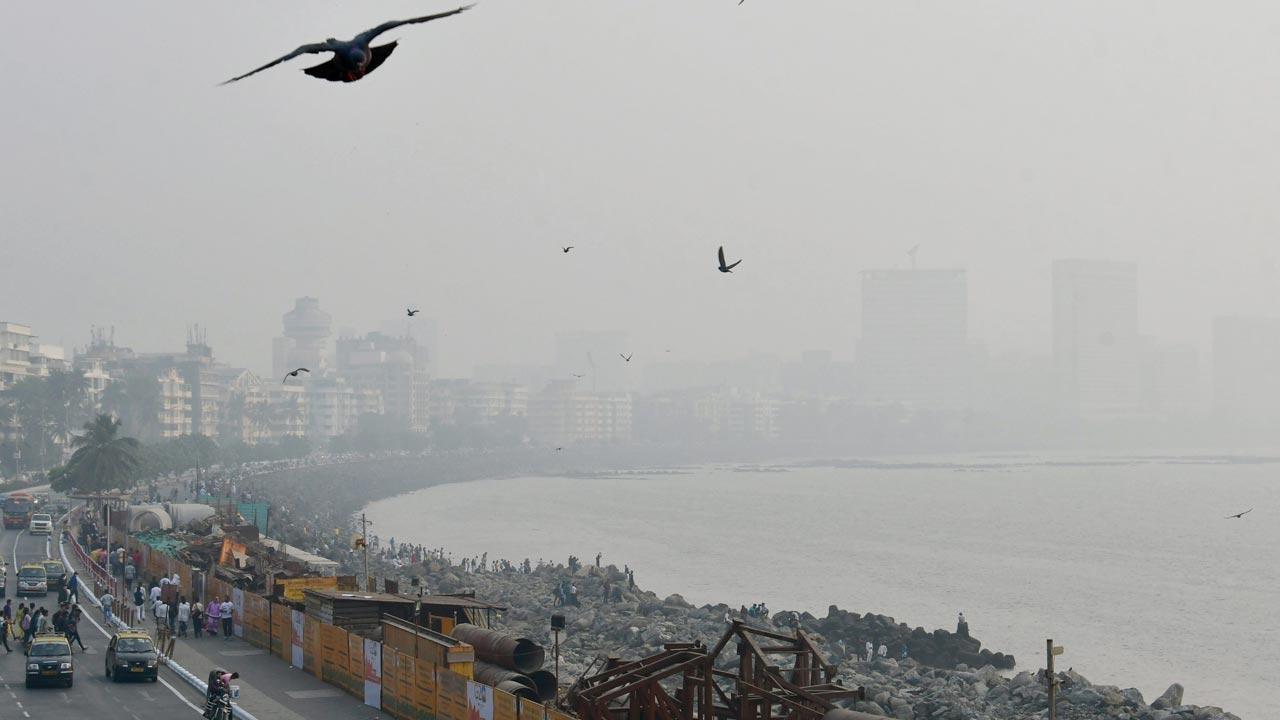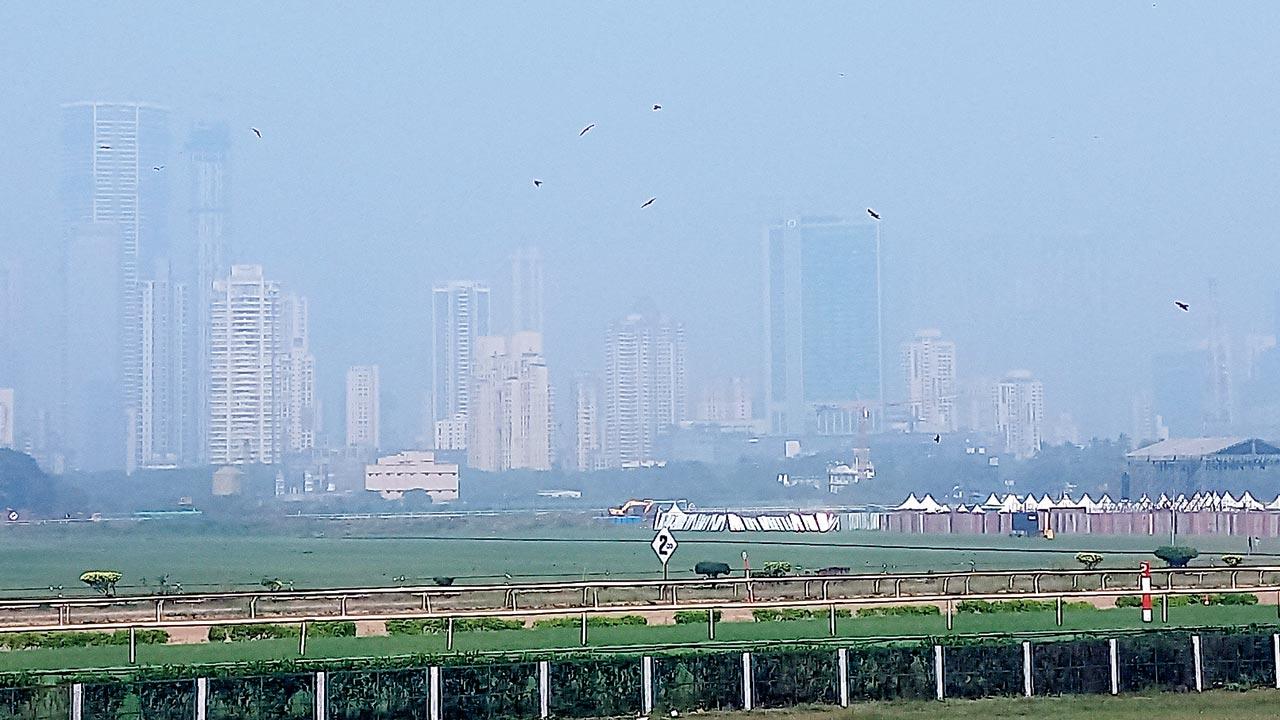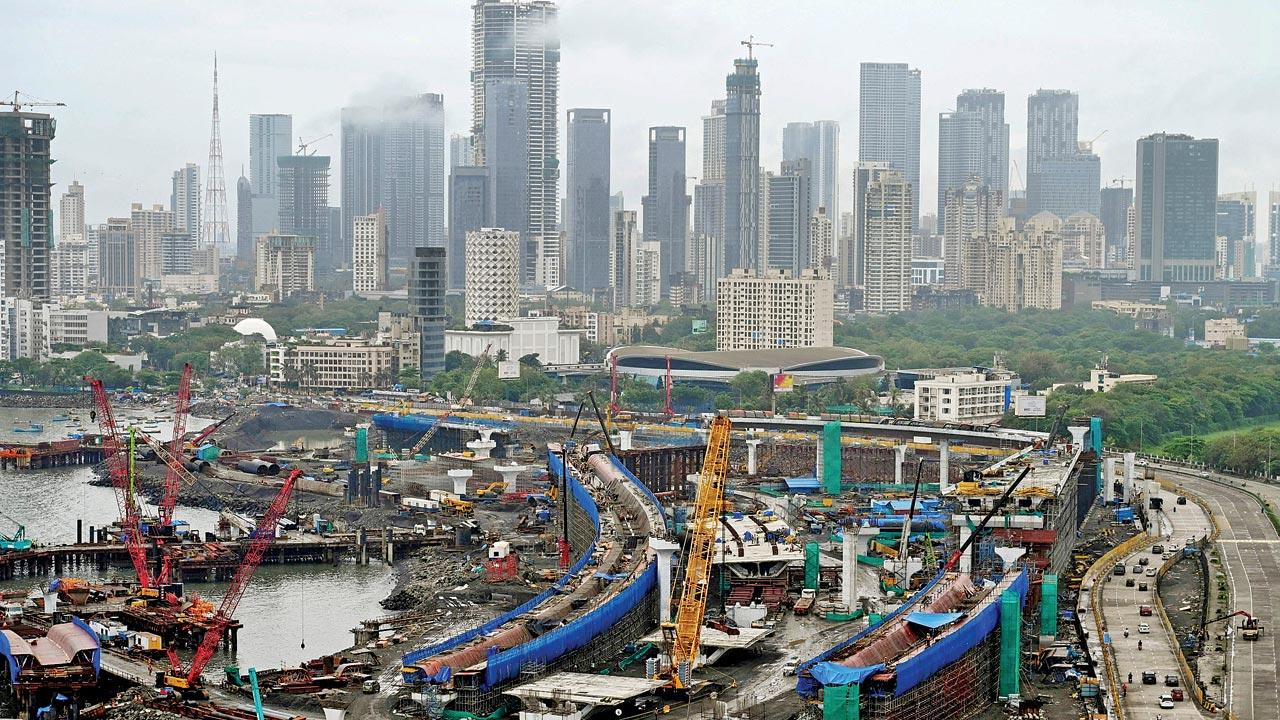Time is of essence in the city’s fight against poor air quality. We got the experts to suggest practical solutions that citizens, policy makers and construction firms must adopt immediately if we want to avoid Delhi’s hell

Mumbai’s showcase neighbourhood Marine Drive has been a dump of debris for the last four years with the ongoing Coastal Road construction. Experts say large-scale road and realty construction account for 70 per cent of particulate matter in the city’s air. Pic/Getty Images
It's getting harder to breathe in Mumbai. Over the last few days, the Air Quality Index (AQI) has risen exponentially, with the System of Air Quality Forecasting and Research (SAFAR), a national initiative of the Ministry of Earth Sciences (MoES), recording AQI worse than Delhi. Several areas, including Mazgaon, Chembur and Malad, were reported to be in the “poor” category, recording an AQI of 200 and above.
ADVERTISEMENT
Dr Anjal Prakash, research director, Bharti Institute of Public Policy, ISB, and Intergovernmental Panel on Climate Change lead author, breaks it down in layman’s terms. “Air pollution is caused by solid and liquid particles and certain gases that are suspended in the air. For Mumbai, two major primary pollutants are particulate matter [PM2.5 and PM10] and nitrogen dioxide [NO2],” he says in an email interview. On December 14, when this writer reached out to Dr Prakash, the PM2.5 concentration in Mumbai, he shared, was 2.1 times above the limit of the value recommended by the WHO’s 24-hour air quality guidelines (15 μg/m3).
 Several areas, including Mazgaon, Chembur and Malad, were reported to be in the ‘poor’ category, recording an AQI of 200 and above in the early part of last week. Pic/Sayyed Sameer Abedi
Several areas, including Mazgaon, Chembur and Malad, were reported to be in the ‘poor’ category, recording an AQI of 200 and above in the early part of last week. Pic/Sayyed Sameer Abedi
Exposure to high concentrations of small particulates (PM10 and PM2.5) has been linked with increased mortality or morbidity, daily and over time.
The darts are coming from everywhere. A SAFAR study from 2019-2020 states that the biggest contributors to PM2.5 particles in Mumbai are vehicular emissions (30.5 per cent), followed by the industries and power sector (18 per cent) and domestic source (15 per cent). “Rampant road and realty construction contribute to around 70 per cent of the particulate matter in Mumbai’s air,” says Prakash, adding that “it’s one of the real challenges the city is facing.” Climate change is also turning out to be a silent disruptor. “One of the reasons [for Mumbai’s air quality dipping to unhealthy levels] is the prevailing global meteorological conditions called the El Nino Southern Oscillation (ENSO). This abnormal warming of the tropical Pacific Ocean disrupts global atmospheric circulation and, in turn, influences temperature and precipitation.” He states that the latest IPCC report too, confirmed “that global warming has rapidly accelerated environmental conditions in India”.
Is Mumbai doing enough to contain this storm? In March this year, the Uddhav Thackeray government had launched the Mumbai Climate Action Plan (MCAP) 2022, a first-of-its-kind document on future environmentally-conscious policies, towards mitigating and adapting to the effects of climate change. Improving air quality was a prominent aspect of this docket. Though it’s too soon to predict how MCAP will be implemented, the current strategies hardly seem foolproof. “If they were effective, Mumbai wouldn’t have been going through the problem we are experiencing,” feels Prakash. According to him, the policies to reduce air pollution have been heavily influenced by the Maharashtra Pollution Control Board. “Although it seems efficient, it has a staffing problem. What is needed is a lateral entry for people who work on the issues of air pollution as well as ground-level staff to monitor and reinforce regulations. Apart from this, better alignment is needed with the Government of India’s National Clean Air Programme (NCAP), which provides cities a comprehensive framework for creating air quality management plans and policy recommendations in several fields.”
 Dr Anjal Prakash, Polash Mukerjee, Piyush Tewari and Dr Rakesh Kumar
Dr Anjal Prakash, Polash Mukerjee, Piyush Tewari and Dr Rakesh Kumar
Earlier this month, a new research paper published on IOPScience, explored how mitigation efforts adopted by a city can reduce the risk of mortality. The study investigated the air quality and health co-benefits of climate solutions in Ahmedabad—one of 132 cities in India with air pollution levels above national health-based standards—through an interdisciplinary modelling approach. Polash Mukerjee, lead, Air Quality, Natural Resources Defense Council (NRDC) India Programme, who was part of the study, tells mid-day that climate change, air pollution, and extreme heat are interconnected public health threats. “Our paper, which is a result of a three-year-long study and is a first-of-its-kind, has attempted to assess the health impacts of climate action and air pollution interventions in a particular city.” Ahmedabad developed and launched South Asia’s first heat action plan (HAP) in 2013, an effort integrating heat forecasting with improved municipal governance, health risk communication, and land cover interventions, including reflective cool roof. “We modelled the 2018 baseline versus the 2030 end line in the city, and assessed what would be the cooling demand, as a result of temperature rise.” While there would be an increase in the cooling demand, energy for this would come through existing sources. “We’ve modelled the air pollution impact of this additional demand for cooling, as well as the impact of specific interventions.” The findings, he says, indicate that thousands of lives could be saved if specific climate interventions, such as cool roofs and higher renewable energy deployment, are adhered to.
The manner in which air quality is monitored also needs to be looked into. Dr Rakesh Kumar is Officer on Special Duty at Council of Scientific and Industrial Research (CSIR). New Delhi. He says that while continuous monitoring stations have been installed in several parts of the city, the problem currently is with where they are located. The Central Pollution Control Board (CPCB) has in its guidelines stipulated that the ambient air quality data should represent at least 3 to 4 km radius of an area. “But the data that’s getting used is of stations that are actually close to highways and other source sites, and these will typically show higher values,” he says. While this might seem like a good thing, it’s not really representative of the real ambient air quality. “I think there should be at least two or three categories of indexes—one that records ambient air, a second which measures air quality at source or hotspots, and a third which is what we call the urban background station [the levels are representative of the exposure of the general urban population]. All the data should be compared with the samples procured from the UB station to understand if there’s cause for concern.” He says that when the BMC used to monitor air quality levels in all the wards, Borivli was the background station. “Now, the pollution control board and SAFAR monitor data. Both need to be reconciled properly and used for communication and source specific actions.”
 Dr Anjal Prakash, lead author of IPCC, says that rampant road and realty construction contribute to around 70 per cent of the particulate matter in Mumbai’s air. Pic/Getty Images
Dr Anjal Prakash, lead author of IPCC, says that rampant road and realty construction contribute to around 70 per cent of the particulate matter in Mumbai’s air. Pic/Getty Images
Prakash states that the process of gathering air quality data becomes effective, when it is merged with health data, especially those caused by air pollution, to understand the sources of pollution and its impact on people’s lives. “This is more for people living in low-income settlements as air pollution is a silent killer, and sometimes it suffers from attribution. Real-time, organised, thorough, and efficient data transmission will make analysis easy for taking appropriate policy measures and will mitigate the effect better.”
On the ground, however, a host of measures can be implemented to deal with the problem. While the BMC last week banned construction activities for 10 days, Kumar says, temporary solutions hardly work in the long-term. “Construction practices have to change. When it comes to areas where digging, breaking and crushing activities are done, they still use water sprinklers. This is primitive. I’d recommend using dust suppressants instead. Similarly, we now also have smart devices to keep the moisture levels high in construction areas, so that the dust is contained and doesn’t travel.”
Mukerjee of NRDC India points to a more long-pending issue that needs urgent attention. “In 2015, the Government of India notified emission stands for thermal plants. It was supposed to be implemented from December 2017 onwards. This year, the deadlines have been pushed to 2026. That’s a nine-year delay. These emissions affect every city of India. While research papers have discussed that the highest impact of a power plant is within a 50-100 km radius, there may still be a significant impact 600-800 km away depending on the wind speed and other meteorological factors.”
In a city riddled with the problem of poor road infrastructure, Piyush Tewari, founder of Savelife Foundation, a non-profit committed to saving lives on roads in India, offers another important perspective: “Infrastructural issues are the primary contributors to unsafe roads where road crashes are witnessed. Road crashes in turn, impact the environment in multiple ways. A few of these include automobile wreckages that become a part of the unusable end-of-life vehicles and scrappage. By 2025, it is estimated that India would have about 22.5 million end-of-life vehicles.
These road crash vehicles and old end-of-life automobiles lie rotting by the wayside, in landfills or informal recycling facilities. Their unscientific dismantling or decay leads to the leakage of hazardous constituents such as oils, coolants, glass wool.”
Apart from better road infra, a significant step to protecting the environment would be to have better scrapping measures of end-of-life vehicles and road crash wreckages. “Missing signages contribute to lack of timely awareness and possible crashes, injuries and fatalities. Usually, asbestos—that has an adverse impact on the environment—is used to create these signages. We employ only long-lasting, high-quality, non-hazardous Aluminium Composite Panels (ACP). We also need green corridors that go over forests and animal walkways, instead of through them to ensure that wayside trees do not fall prey to road widening initiatives. Instead of felling trees to avoid collision propensity, crash barriers can be used to guard them.”
 Subscribe today by clicking the link and stay updated with the latest news!" Click here!
Subscribe today by clicking the link and stay updated with the latest news!" Click here!







